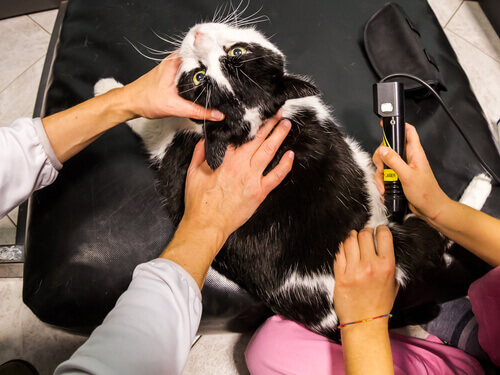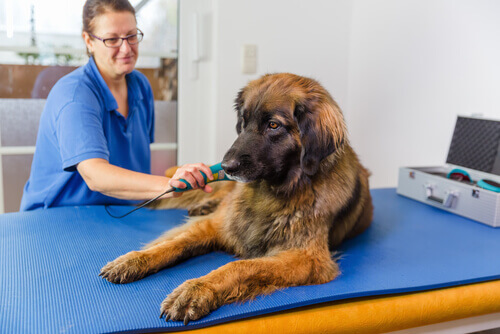All About the Use of Laser Therapy in Pets

The use of laser therapy in pets has been on the rise in recent years at veterinary clinics. The purpose of this form of therapy is to treat different pains and discomforts, especially in dogs and cats.
We’re coming across more and more information regarding the different benefits of lasers as a complementary treatment. However, it’s not all true. That’s because, to a great degree, knowledge comes from experience.
From a scientific perspective, based on veterinary medicine, there’s very little current literature on the subject. In fact, the information we do have dates back more than 10 years. What we know today about laser therapy comes from studies that took place in laboratories or with human beings, from a practically subjective point of view.
However, certain studies on animals demonstrate that laser treatment is effective. What’s more, it speeds up recovery from certain illnesses.
Given the lack of observations and objective studies based on scientific evidence, the true value of laser therapy in pets remains unknown. However, we’ll tell you about its different applications and effects .
What is laser therapy in pets?
The word laser is an acronym that stands for light amplification by the stimulated emission of radiation. This type of concentrated light can be absorbed by different tissues in the organism. This way, it produces different photothermic and photochemical reactions that can have therapeutic benefits.
When it comes to rehabilitative laser treatment, specialists use a low-intensity laser. This is different from high-power surgical lasers that serve to destroy tissues and cells in a controlled manner.
Currently, experts are unaware of the exact interaction between tissues and lasers. This is because, as we said, there’s a lack of scientific research. However, experience has demonstrated that it produces change.

Illnesses where laser therapy may be beneficial
First of all, in order to understand why laser is only used for certain illnesses, we must understand how this therapy acts on the body.
Biologically, the animal’s tissue absorbs the photons that the laser emits. This then produces an increase in adenosine triphosphate or ATP, an essential molecule in the obtaining of cellular energy. This production of ATP alters cellular metabolism and can also act as a neurotransmitter. Therefore:
- Laser therapy can help to relieve pain
- It accelerates cell growth and tissue repair
- Apparently, it stimulates the creation of stem cells
- It has anti-inflammatory effects
Laser therapy to improve osteoarthritis
Some of the most common chronic illnesses in cats and dogs are those that affect their joints. Animals that suffer from inflammation and pain usually have difficulty moving. In these cases, treatment normally involves chondroprotective agents and special weight-loss diets. However, laser therapy also seems to cause improvement.
In studies on lab rats, laser reduced the edema around joins and decreased pain significantly. However, in studies involving humans, there didn’t seem to be an improvement.
Tendon and ligament injuries
The use of laser therapy in humans with problems or damage to their ligaments and tendons is very common. However, only 50% of patients experience improvement. If the chances of positive results in animals are the same as in humans, then this is a good enough reason to give it a try.
Managing pain and inflammation
While experts are unaware of how it occurs, evidence suggests that laser therapy in pets helps reduce pain in pets. It seems that, by interacting with pain receptors, laser reduces the feeling of pain. In the same way, laser therapy could have effects on the neurons that control vasoconstriction and, therefore, mediate in inflammatory processes.

When do experts recommend laser therapy in pets?
Veterinarians may recommend laser therapy in almost any case. However, it’s usually applied in those cases where the normal treatment isn’t a possibility or isn’t working:
- Animals with liver problems that can’t take certain medications.
- Cats that can’t take pharmaceuticals to reduce pain.
- Exotic pets that, given their low body weight, can’t take medication.
- Pets that are getting on in years and have multiple pathologies.
- Animals with rare illnesses.
Laser therapy is very safe, as long as specialists administer it correctly. In other words, a veterinarian that specializes in these alternative therapies must configure the treatment and establish the right number of sessions for each case.
Despite a lack of scientific evidence, in certain situations it’s not a bad idea to consider laser treatment as an option.
All cited sources were thoroughly reviewed by our team to ensure their quality, reliability, currency, and validity. The bibliography of this article was considered reliable and of academic or scientific accuracy.
- Crespi, R., Covani, U., Margarone, J. E., & Andreana, S. (1997). Periodontal tissue regeneration in beagle dogs after laser therapy. Lasers in Surgery and Medicine: The Official Journal of the American Society for Laser Medicine and Surgery, 21(4), 395-402.
- de Braekt, M. M. I., van Alphen, F. A., Kuijpers‐Jagtman, A. M., & Maltha, J. C. (1991). Effect of low level laser therapy on wound healing after palatal surgery in beagle dogs. Lasers in surgery and medicine, 11(5), 462-470.
- Draper, W. E., Schubert, T. A., Clemmons, R. M., & Miles, S. A. (2012). Low‐level laser therapy reduces time to ambulation in dogs after hemilaminectomy: a preliminary study. Journal of Small Animal Practice, 53(8), 465-469.
- Dougherty, T. J., Thoma, R. E., Boyle, D. G., & Weishaupt, K. R. (1981). Interstitial photoradiation therapy for primary solid tumors in pet cats and dogs. Cancer research, 41(2), 401-404.
- Kerwin, S. C. (2010). Osteoarthritis in cats. Topics in companion animal medicine, 25(4), 218-223.
- Peavy, G. M., Walder, E. J., Nelson, J. S., & Rosenberg, M. (2001). Use of laser photocoagulation for treatment of cutaneous angiomatosis in one dog and two cats. Journal of the American Veterinary Medical Association, 219(8), 1094-1097.
